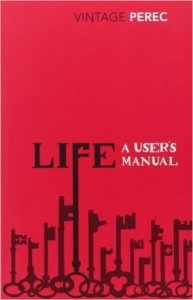 I first came across Georges Perec’s work at university through his first novel ‘Things: A Story of the Sixties’ which was by far the most interesting book I had to read for one of my French literature modules focusing on consumerism. I’ve had ‘Life: A User’s Manual’ on my TBR list ever since which is probably Perec’s best known novel published in 1978 and translated from the French by David Bellos in 1987.
I first came across Georges Perec’s work at university through his first novel ‘Things: A Story of the Sixties’ which was by far the most interesting book I had to read for one of my French literature modules focusing on consumerism. I’ve had ‘Life: A User’s Manual’ on my TBR list ever since which is probably Perec’s best known novel published in 1978 and translated from the French by David Bellos in 1987.
The narrator guides the reader from room to room in an eight-storey apartment block at 11 Rue Simon-Crubellier, a fictional street in the 17th arrondissement of Paris. This microcosm contains several bizarre characters and long descriptions of the objects they own and meandering digressions about how they came to own them. Set across a single day, 23rd June 1975, the novel also relies on flashbacks to explain the back stories of the inhabitants of 11 Rue Simon-Crubellier.
The closest thing to a central character is probably Bartlebooth, a wealthy Englishman who is completing a lifelong project which involves learning to paint watercolour landscapes, producing seaside landscapes in 500 locations across the world and then having his neighbour Gaspard Winckler turn them into 750-piece jigsaw puzzles before reassembling them again and reversing the process. He is just one of many eccentric characters which populate the rest of the book who are constrained by arbitrary structures. Even the order in which the rooms are described is based on a mathematical equation which determines how a knight can move on a chessboard – something I only discovered after finishing the book. Perec’s strict focus on structure contrasts heavily with the novel’s overall message of life being imperfect and incomplete. However, if you are the kind of the reader who enjoys lists, then you may find the book is also weirdly uplifting in its obsessive detail.
Through Bartlebooth’s project, it becomes apparent that ‘Life: A User’s Manual’ is best read in the manner of piecing together an intricate jigsaw puzzle from which a large portrait slowly emerges from a large number of stories and themes. With relatively few connections between the apartment’s occupants, each of the 99 chapters can be read as a short story, yet the whole effect is equally as great as the individual parts. Inevitably, I suspect some of Perec’s wordplay and more complex puzzles may have been slightly lost in translation but the English text still remains faithful to the spirit of his prose.
‘Life: A User’s Manual’ is far from being a practical self-help guide as its title suggests. Experimental in form yet based on a relatively accessible concept, it is one of the most fascinating works of 20th century French literature.





It’s a wonderful book, isn’t it? It was the first Perec I read, and I love it!
LikeLike
Yes I’ve never read anything quite like it before and found it quite hard to describe! I think I will try ‘A Void’ as my next Perec book.
LikeLiked by 1 person
Must admit that I’ve had a go at this and put it aside because of its dryness. A Void, on the other hand, is based on a writing ruse that appeals to me as someone who writes using coding and algorithms. The avoidance of the vowel ‘e’ forced him to make extreme, often nonsensical, but fun excursions. Life does sit there awaiting my attention though. Maybe one of those books that has a right time. I only got into If on a Winter’s Night on the 3rd or 4th go!
LikeLike
Yes the mathematical approach is particularly interesting – I had Life: A User’s Manual on my TBR list for about 5 years but it is worth getting to eventually.
LikeLike
Oh I’ve had it for years and attempted it twice. Maybe there’s an equivalent To Life: A User’s Manual to be written about the lives of books on a bookshelf? Books: A User’s Manual would chart the fortunes of some unfinished titles on a shelf, running the risk of being left unfinished on shelves elsewhere!
LikeLiked by 1 person
One of my favourite novels! A shame some read only this of Perec’s work though – as you point out, his other books are well worth exploring. A Void is an astonishing feat of writing and translation!
LikeLike
Yes, I’m intrigued by ‘A Void’ given that it’s the book where Perec avoided words containing the letter “e” and how that works in another language!
LikeLike
These Oulipo constraint-based books are interesting but problematic: it’s a long tradition, though, going back to Cervantes, Sterne & co – the novel that poses as something else. I had a piece a while back st T Days on Calvino & this sort of thing. Must revisit Perec – thanks for this.
LikeLike
This looks so intriguing! Okay, definitely going to the TBR list!
LikeLike
Great, hope you enjoy it!
LikeLiked by 1 person
I’m intrigued.
LikeLiked by 1 person
Great review! I loved this book and have read a couple of others based on the idea of the apartment building as a microcosm – Alaa Al Aswany’s The Yacoubian Building and Manil Suri’s The Death of Vishnu come to mind – but none as good as Perec’s. I might have to read it again, now.
LikeLike
Thanks! I’ll look out for those books too.
LikeLiked by 1 person
I’ve loved just about every Oulipo book I’ve read so this one is headed to the top of my list! Playing with language is so much fun.
If you’re looking for a great Oulipo translation I recommend Queneau’s Exercises in Style – Barbara Wright does an amazing job adapting the linguistic gymnastics into English and her translator’s note is a joy in itself.
LikeLike
Yes I’ll definitely be looking into more Oulipo authors – the books and translations all sound fascinating.
LikeLiked by 1 person
I love lists, so I guess this is for me? I just put it on my TBR list, I’ll definitely give it a try!
LikeLike
Hope you enjoy it!
LikeLiked by 1 person
I will definetly read this in French!! (I am a list person haha) A similar book is “Pond” which I didn’t start liking, but the style grew on me and it’s one of my favorite finds of the year. I have a review up, and also a post with some extracts if you ever want to give it a try!
LikeLike
Thanks, I will check it out!
LikeLiked by 1 person
Pingback: My Books of the Year 2016 | A Little Blog of Books